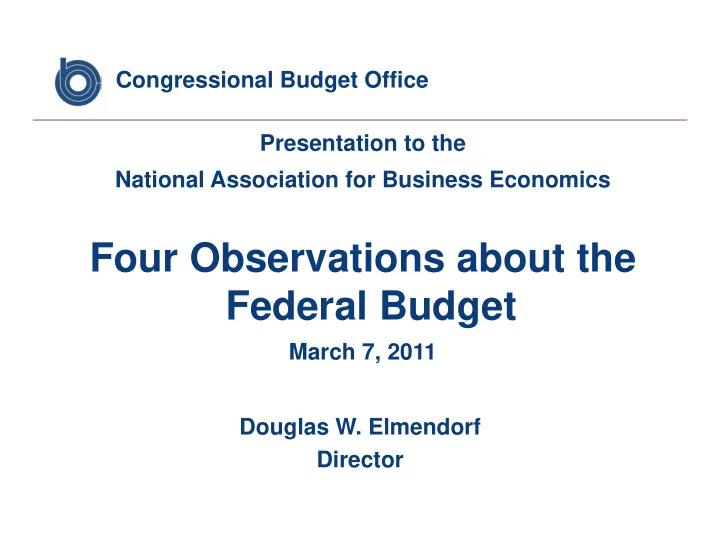

Congressional Budget Office Presentation to the National Association for Business Economics Four Observations about the Federal Budget March 7, 2011 Douglas W. Elmendorf Director
Four Observations about the Federal Budget 1. The gap between spending and revenues is likely to remain very large even after we return to normal economic conditions. 2. Fiscal policy cannot be put on a sustainable path just by eliminating waste and inefficiency; the policy changes that are needed will significantly affect popular programs or people’s tax payments or both. 3. Policymakers face difficult tradeoffs in deciding how quickly to implement policy changes that would reduce future budget deficits. 4. There is more focus in Washington on federal budget problems today than there has been since the late 1990s, and that focus has led to a range of proposals for tackling the problems. 2
Observation #1 The gap between spending and revenues is likely to remain very large even after we return to normal economic conditions. 3
Deficits Under CBO’s Baseline or with a Continuation of Certain Policies, Compared with Past Deficits and Surpluses Percentage of GDP 4 4 Actual Projected 2 2 0 0 - 2 - 2 Baseline - 4 - 4 - 6 - 6 Continuation of Certain Policies - 8 - 8 - 10 - 10 - 12 - 12 1971 1976 1981 1986 1991 1996 2001 2006 2011 2016 2021 4
Federal Debt Held by the Public Under CBO’s Baseline or with a Continuation of Certain Policies, Compared with Past Debt Percentage of GDP 120 120 Actual Projected 100 100 Continuation of Certain Policies 80 80 Baseline 60 60 40 40 20 20 0 0 1940 1949 1958 1967 1976 1985 1994 2003 2012 2021 5
Debt Burden Across Countries in 2009 Percentage of GDP Japan Italy Greece Belgium Hungary Portugal France Germany UNITED STATES United Kingdom Iceland 2021 CBO With Baseline Continuation of Austria Certain Policies Spain Netherlands Ireland Canada Poland Slovak Republic Switzerland 0 20 40 60 80 100 120 Source: For the United States, debt held by the public net of financial assets. For other countries, general government debt 8 net of financial liabilities as reported by the Organisation for Economic Co-operation and Development.
Observation #2 Fiscal policy cannot be put on a sustainable path just by eliminating waste and inefficiency; the policy changes that are needed will significantly affect popular programs or people’s tax payments or both. 7
Shares of Federal Spending in 2010 Percent Transfer payments to people in the United States 47 Grants to state and local governments 14 19 Purchases of goods and services for defense Purchases of goods and services for nondefense 9 8 Interest Other (includes transfers to people outside the U.S.) 4 Source: National Income and Product Accounts. 8
Outlays for Some Major Federal Programs Compared with Total Federal Revenues Percentage of GDP 22 Actual Projected Outlays for Social Security, Medicare, Medicaid, Other Health Programs, 20 Defense, and Net Interest 18 Revenues with Continuation of Certain Policies 16 14 0 2008 2009 2010 2011 2012 2013 2014 2015 2016 2017 2018 2019 2020 2021 9
Projected Federal Revenues and Spending in 2021 with a Continuation of Certain Policies 5
Components of the Federal Budget 2021 1970 2007 January Baseline Percentage of GDP Revenues 19.0 18.5 20.8 Outlays 19.3 19.6 24.0 Social Security, Medicare, Medicaid, health insurance subsidies, and 3.8 8.2 12.0 other health programs Defense 8.1 3.9 3.6 Other mandatory spending 6.0 5.8 5.0 and nondefense discretionary spending Net interest 1.4 1.7 3.3 Deficit 0.3 1.2 3.2 7 Note: Figures are shown net of offsetting receipts where relevant.
Observation #3 Policymakers face difficult tradeoffs in deciding how quickly to implement policy changes that would reduce future budget deficits. 12
Disadvantages of Reducing Deficits Gradually Rather than Quickly Reduces the amount of U.S. savings devoted to productive capital investment. Requires greater federal spending on interest payments. Gives policymakers less flexibility to respond to unexpected problems. Increases the likelihood of a fiscal crisis. 13
Advantages of Implementing Major Budgetary Changes Gradually Possibly helps older generations. Minimizes the drag of spending cuts or tax increases on the economic expansion. Gives families, business, and state and local governments time to plan and adjust. 14
Making Decisions Soon About How to Put Fiscal Policy on a Sustainable Path Would Be Beneficial Enacting policy changes soon: – Would allow for gradual implementation while still limiting further increases in federal debt; and – Would probably provide some boost to economic activity by reducing uncertainty and holding down interest rates. 15
Observation #4 There is more focus in Washington on federal budget problems today than there has been since the late 1990s, and that focus has led to a range of proposals for tackling the problems. 16
Plans to Narrow the Budget Gap The plans are diverse : They reflect widely varying priorities, with some emphasizing spending cuts and others emphasizing tax increases. Yet, they are similar in some significant ways. The plans propose policy changes that: – Are large in magnitude; – Are fairly well-specified; and – Would fundamentally alter the tax code and some of the activities of government. 17
Recommend
More recommend